The public institution dedicated to the conservation and restoration of Notre-Dame de Paris Cathedral has officially partnered with Autodesk. This collaboration aims to support the ongoing efforts to restore one of the world’s most iconic landmarks through advanced design and construction technologies. As part of this partnership, Autodesk is providing Building Information Modeling (BIM) support, intelligent data management, and 3D geometric modeling solutions. These tools are crucial in creating a detailed digital record of the cathedral, ensuring better resilience and preparedness for future restoration work.
By adopting this innovative digital approach, the institution is enabling seamless cloud-based collaboration among all stakeholders involved in the restoration. A centralized data environment allows authorized parties to access real-time project information, improving transparency and efficiency throughout the process.
Before the tragic fire, reality capture technologies were used to create an accurate 3D BIM model of the cathedral. Autodesk then utilized recent scans taken after the incident to develop post-fire models, allowing for precise comparison and informed decision-making during the restoration. This digital documentation serves as a vital resource not only for the current work but also for future preservation efforts.
The use of these cutting-edge technologies is playing a key role in preparing the cathedral for its reopening and ensuring that it continues to welcome pilgrims and visitors from around the world. The digital models provide a comprehensive view of the structure, helping architects and engineers make informed choices while maintaining the historical integrity of the building.
“I warmly thank Autodesk for supporting the rebirth of Paris’ Notre-Dame Cathedral. Utilizing digital tools for site supervision and management is essential for our institution. Thanks to Autodesk’s support, we are leveraging the latest design and construction technologies, including BIM, to help prepare for the cathedral’s reopening and ensure it once again becomes a place of worship and inspiration,†said Army General Jean-Louis Georgelin, President of the public establishment.
“We are honored to be part of the restoration and long-term preservation of the Notre-Dame Cathedral, a true architectural masterpiece. Since the devastating fire two years ago, we have supported the effort through the French Fondation du Patrimoine, and this partnership reaffirms our commitment to using technology for cultural heritage,†said Nicolas Mangon, Vice President of Business Strategy for Architecture, Engineering, and Construction Design Solutions at Autodesk.
The collaboration between the public institution and Autodesk highlights the power of digital innovation in preserving historic landmarks. With the integration of BIM and 3D modeling, the restoration of Notre-Dame is not only more efficient but also more precise, ensuring that every detail is carefully considered and preserved for future generations.
Polyester Polyol
Polyester polyols are the important raw materials of coating, adhesives, elastomer and foam.
Polyester polyols can be divided into aromatic polyols and aliphatic polyols because of the acid and polyols.
Aromatic polyols are mostly used in preparing PU rigid foam which foam has great thermal insulation ability.
Aliphatic polyols with different raw materials show different performance.
No mater aromatic polyols or aliphatic polyols, we can provide the special products according to customers` requirement.


Polyester polyol is a type of polyol that is derived from the reaction between a polyol (such as glycerol or ethylene glycol) and a dicarboxylic acid (such as adipic acid or phthalic anhydride). It is commonly used as a raw material in the production of polyurethane foams, coatings, adhesives, and elastomers.
Polyester polyols have several advantages over other types of polyols. They have good chemical resistance, mechanical properties, and thermal stability. They also have low toxicity and are environmentally friendly. Additionally, polyester polyols can be easily modified to achieve desired properties, such as increased flexibility or flame retardancy.
Polyester polyols are typically liquid at room temperature and have a high molecular weight. They can be further reacted with isocyanates to form polyurethane materials, which have a wide range of applications in various industries, including automotive, construction, and furniture.
Tpu Polyester Polyol,coating for synthetic leather,Polymeric Polyol Resins,L Polyester Polyol Raw Materia
XUCHUAN CHEMICAL(SUZHOU) CO., LTD , https://www.xuchuanchem.com

